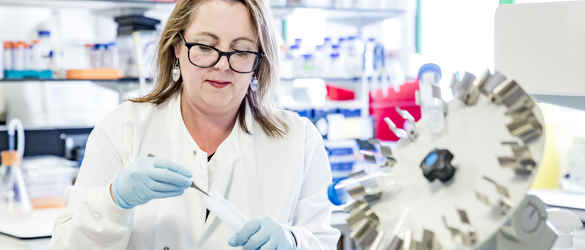Pattern dystrophy
Pattern dystrophy is the umbrella term for a group of retinal conditions. All of them cause a build-up of waste material called lipofuscin, which causes damage to tissue in the eye.
Different dystrophies cause different patterns of damage, which might look like egg yolks, butterflies or knotted fishing nets. People will usually have symptoms in both eyes, and may have a different pattern of damage in each.
How is it inherited?
Pattern dystrophies are caused by mutations (or mistakes) in one of several genes, but they are all inherited in an autosomal dominant fashion. That means that someone with a pattern dystrophy has a 50 per cent chance of passing it on to their child, whether they are male or female. The gene is not always ‘expressed’ in the same way, so someone with significant sight loss may have a child with only mild visual impairment.
What are the symptoms?
The symptoms of pattern dystrophy are similar to age-related macular degeneration (AMD), but tend to be less severe. Despite some blurring of vision and loss of fine detail, people are usually able to drive and read the newspaper. Often, the lipofuscin deposits are picked up during a regular eye test before the patient notices any sight loss.
Although symptoms do get worse, this usually happens very slowly, over 20 to 30 years. Around 15 per cent of people develop new, leaky blood vessels in their eye tissue (like wet AMD ). A similar proportion find that patches of the light-sensing cells in their retina start to die off due to geographic atrophy (also a symptom of dry AMD ). This usually happens in people aged over 60.
Treatment
No treatments currently exist for pattern dystrophy. People who develop wet AMD-type symptoms may be treated with anti-VEGF injections to slow the growth of new blood vessels.
Research
Our understanding of the genetic changes which cause pattern dystrophy is improving every year. Future treatments for AMD and other dystrophies may be effective for pattern dystrophy too.
Explore our research projects
Since 1987 the Macular Society has invested around £10 million in over 100 research projects.
Looking for more information about living with an inherited macular dystrophy?
Call the Macular Society Helpline on 0300 3030 111 or email help@macularsociety.org
Last review date: 08 2021
Support for you
We provide free information and support to those with macular disease, along with their family and friends, to help people keep their independence.
Are you a young person or of working age?
The Macular Society supports everyone impacted by macular disease, including those with less common types of macular disease who may be younger or still working.
Free confidential advice and support
Call our helpline on 0300 3030 111
Lines are open 9am - 5pm Monday to Friday
About the Macular Society Helpline




